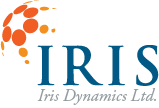Rehabilitation and Force Feedback
- January 26, 2023
Rehabilitation and Force Feedback
Physiology Meets Machines: Force Feedback, Rehabilitation and Brain Injury
Haptics offer information about touch, while force feedback is the ability of receptors in our organs to perceive varying levels of force, which results in action by the musculoskeletal system. Physiological force feedback, for example, is essential when walking or running. Touch sensors on the soles of the feet along with the force feedback that the muscles, tendons, and tissues perceive and dictate the pattern in which the musculoskeletal system will move. Thus, it is clear that in haptic mechanics, both physiologically and mechanically, force feedback is assumed to be an important part of the control system and compliance.
When we look at the current use of external haptic devices that use touch and force feedback, this is typically accomplished through vibration (applications are widespread in the gaming community, surgical devices, motion stimulation, etc.)1 2 The data collected from these applications provides positive evidence that the technology is engaging for the user and that there is variability and flexibility in its application in a range of environments3.
This article proposes the use of haptic mechanics and force feedback interfaces in the medical industry with particular reference to rehabilitation following injury.
Brain Injury: Rehabilitation and Force Feedback
One of the most common forms of neural injury is stroke, which is a leading cause of long-term disability. Stroke poses a significant burden to the patient, their families and society alike4. Standard therapy through a rehabilitation program is typically offered to enhance function of the sufferer following a stroke, however, it remains that 55-75% of stroke survivors continue to experience functional limitations5.
In a stroke model, haptic sensors and force feedback mechanics have been well-studied in their role in bilateral rehabilitation, where hemiparesis is a common result of the resulting brain injury. The addition of mechanics and their aim to promote rehabilitation of the injured side is prominent in stroke rehabilitation literature6.
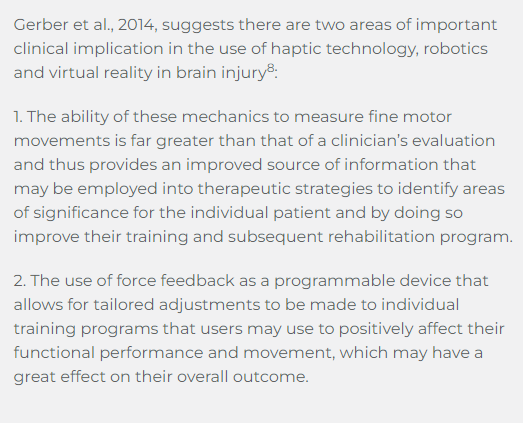 The use of haptics and force feedback devices are employed in the program as a specific means to target the plasticity of the brain. Neuroplasticity describes the ability of the nervous system to adapt and change to various responses within its environment. It has been described as the ability of the nervous system to be able to reorganize its structure, function, and connections, depending on either intrinsic or extrinsic stimuli.
The use of haptics and force feedback devices are employed in the program as a specific means to target the plasticity of the brain. Neuroplasticity describes the ability of the nervous system to adapt and change to various responses within its environment. It has been described as the ability of the nervous system to be able to reorganize its structure, function, and connections, depending on either intrinsic or extrinsic stimuli.
Neuroplasticity remains an active area of research, particularly when it comes to injury and rehabilitation. A greater understanding of the topic has led to the ability to produce more established and targeted interventions which has provided a major advantage in the area of rehabilitation and brain injury7.
There is a significant body of research to support the use of force feedback mechanics for this process.
Brewer et al., 2008, suggested many individuals with stroke or traumatic brain injury have a tendency to present with reduced ability to use an affected upper limb, most typically due to learned non-use. During therapy, the individual may not strive for certain goals due to difficulty, which has a negative effect on their progress through their rehabilitation program and thus poorer outcomes following rehabilitation, which includes progressive deterioration of motor function 9.
This phenomenon of learned non-use during therapy is not uncommon in the literature, and it is becoming increasingly popular to include the use of haptics, robotics, and virtual reality into the rehabilitation programs of such individuals, which has shown significant and beneficial improvements that may counteract the phenomenon and improve the motor gains in stroke patients 10.

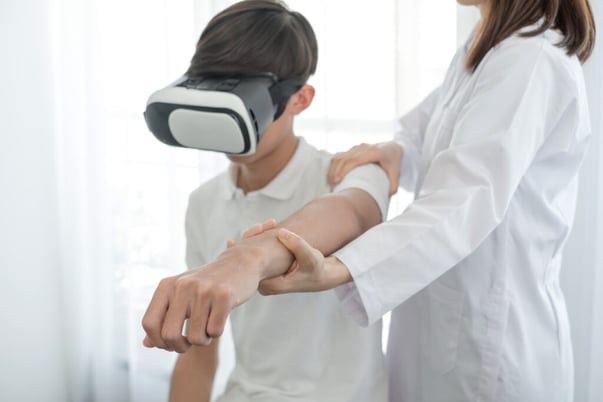
The last point above is reiterated by Lv et al., 2016. This time, the research suggests that costly devices take a long time to develop. When there are design defects, the cost and time to completion significantly increases. Evaluation strategies with these costly robotics may only be accurately gathered once the strategy has been implemented for some length of time.
Additionally, the use of these applications are informed using static images and oral instructions which may make compliance for the patient more difficult.
With the development of virtual reality devices using haptics and force feedback mechanics, these issues may be overcome. Virtual reality environments are not only quicker to develop, they provide a faster degree of evaluation and the application and training purposes are more effective15. A Boy Wearing a VR Headset While a Therapist Examines His Arm
These mechanics have been suggested to be a complementary training tool for conventional rehabilitation approaches. Chia Ng et al., 2016, explains that over and above the cognitive training, the learning and improvement of manual skills is important for the development of activities of daily living (ADL). ADL refers to those activities people carry out on a day-to-day basis that are important for independent living. Examples of these activities include personal grooming, elimination, food preparation, and consumption.
Conventional occupational therapy and rehabilitation programs in the development of ADL require a significant amount of time and guidance from clinicians who are needed for one-on-one supervision. In addition, during task-oriented approaches, the clinician may be required to assess an individual’s needs and then provide an environment specific to this evaluation. The tasks need to be set up, reset again and again during the repetitive task programming, and then cleared up afterwards. Along with the constant evaluation and adjustments to be made, the process is a long and laborious one.
A virtual reality environment allows for these requirements to be computerized. This type of solution offers a more convenient approach to meeting the requirements while enhancing the effectiveness of the therapy when haptics and force feedback mechanics are added.
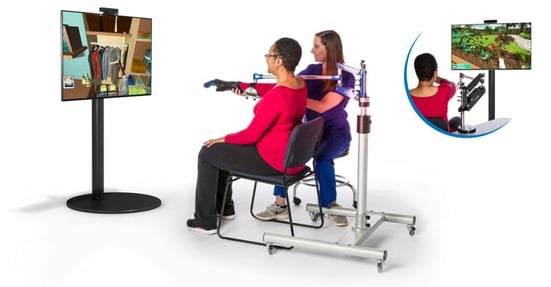 These VR environments have been regarded as a means to improve both motor and cognitive rehabilitation as a simulated environment can be created in such a way as if they were real. Another major advantage is that a VR rehabilitation approach allows for a widely customizable and flexible environment to be created that meets the requirements of each individual patient.
These VR environments have been regarded as a means to improve both motor and cognitive rehabilitation as a simulated environment can be created in such a way as if they were real. Another major advantage is that a VR rehabilitation approach allows for a widely customizable and flexible environment to be created that meets the requirements of each individual patient.No matter how complex the task, VR applications can be fully automated to be repeated with full and enhanced proficiency without increasing the workload of a therapist 16. A great example of this in the real world is SaeboVR and their ADL focused rehabilitation client.
Forcefeedback and VR Used in a Rehabilitation Exercise
Accurate and easily accessible quantitative data can be collected and recorded, which allows for in-training analysis. This information allows the clinician to gain insight into the training program during the therapy session which allows for real-time adjustments to be made and errors quickly corrected 17.
Biofeedback has been presented as being simple, yet effective in the practice of rehabilitation of stroke patients. Afzal et al., 2015, present a patient model of stroke victims using kinesthetic haptic feedback for improvement of balance. External haptic devices are used to detect body tilt and orientation where a stroke patient’s internal sensory response to these physiological changes may be absent or inadequate due to brain injury.
Programs that involve task-oriented exercises using external sensory input have a significant impact on the standing balance of stroke victims which appears to improve the ability of the injured brain to be retrained in sensorimotor function. This results in improvement in post-training postural stability that is retained even after the program has ended 18 19. These are only a few examples of the areas of the application of force feedback mechanics in stroke rehabilitation. The application extends to another common area of research of neuroplasticity: traumatic brain injury.
Traumatic Brain Injury (TBI) and Force Feedback Mechanics
TBI often results from external, violent forces applied to the head. There may be a closed injury, or an associated penetrating injury that results in damage to the brain tissue. In severe cases, typically classified when there is associated loss of consciousness for longer than 30 minutes following the event, the patient may experience a range of significant impairments that may include severely reduced cognitive function, limited function of their limbs, impaired or abnormal speech and/or language, loss of cognitive skills, and emotional imbalances. Recovery is based on the severity of the injury, but also takes the individual’s capabilities into account.
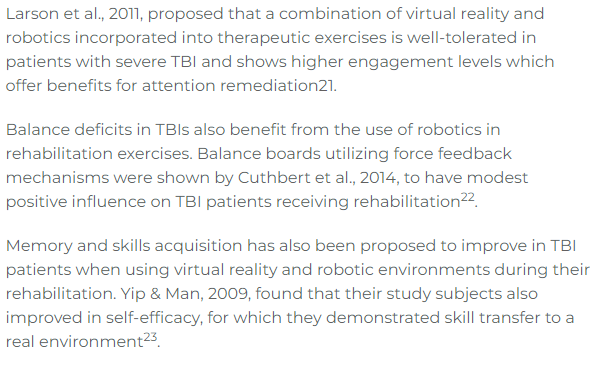 Virtual reality and force feedback mechanisms have been investigated with great interest in TBI recovery. Evidence suggests positive outcomes for a variety of the difficulties a patient faces. The information gathered from virtual reality environments using robotics has been shown to be of adequate reliability and validity. Zhang et al., 2003, evaluated the information collected from a setup of a virtual kitchen wherein TBI patients at varying stages of their recovery were required to perform a set of tasks involving meal preparation. Time and errors on task completion were evaluated and found to provide reliable information for the assessment of those with brain injury when compared to those tasks having to be performed in an actual kitchen environment, OT evaluation, or via neuropsychological tests 20.
Virtual reality and force feedback mechanisms have been investigated with great interest in TBI recovery. Evidence suggests positive outcomes for a variety of the difficulties a patient faces. The information gathered from virtual reality environments using robotics has been shown to be of adequate reliability and validity. Zhang et al., 2003, evaluated the information collected from a setup of a virtual kitchen wherein TBI patients at varying stages of their recovery were required to perform a set of tasks involving meal preparation. Time and errors on task completion were evaluated and found to provide reliable information for the assessment of those with brain injury when compared to those tasks having to be performed in an actual kitchen environment, OT evaluation, or via neuropsychological tests 20.The rapid advancement of technology and virtual reality has both been proposed as and proven to possess great potential in rehabilitation and, in particular, neurorehabilitation and training. From the evidence observed, the need for more automated, easily accessible forms of therapy for stroke patients is significant.
Haptic and force feedback mechanics may help to overcome the limitations imposed by the physical input on clinicians and improve the availability of the massive and intensive sensorimotor stimulation required to induce neural reorganization in people with brain injuries. These techniques, used in conjunction with conventional treatments, may facilitate the activation of brain networks and speed up the recovery process which improves functionality and quality of life in brain injury patients and may potentially improve the burden on them, their families, and the healthcare system.
References
- Application of haptic feedback to robotic surgery. Bethea BT, Okamura AM, Kitagawa M, Fitton TP, Cattaneo SM, Gott VL, Baumgartner WA, Yuh DD J Laparoendosc Adv Surg Tech A. 2004 Jun; 14(3):191-5.
- Broeren J, Sunnerhagen KS, Rydmark M. A kinematic analysis of a haptic handheld stylus in a virtual environment: a study in healthy subjects. J Neuroeng Rehabil. 2007;4(1):13.
- Considerations for the future development of virtual technology as a rehabilitation tool. Kenyon RV, Leigh J, Keshner EA J Neuroeng Rehabil. 2004 Dec 23; 1(1):13.
- Rosamond, W., et al. Heart disease and stroke statistics—2008 update: a report from the American Heart Association Statistics Committee and Stroke Statistics Subcommittee. Circulation. 2008. 117(4):e25–146.
- Kwakkel, G., et al. Probability of regaining dexterity in the flaccid upper limb: impact of severity of paresis and time since onset in acute stroke. Stroke. 2003. 34:2181–2186.
- Adamovich, S., et al. Sensorimotor training in virtual reality: A review. Neurorehabilitation. 2009. 25(1):29-44.
- Turolla, A., et al. Haptic-Based Neurorehabilitation in Poststroke Patients: A Feasibility Prospective Multicentre Trial for Robotics Hand Rehabilitation. Comput Math Methods Med. 2013. 895492.
- Gerber, L., et al. The feasibility of using haptic devices to engage people with chronic traumatic brain injury in virtual 3D functional tasks. J Neuroeng Rehabil. 2014. 11:117.
- Brewer, B., et al. Visual feedback distortion in a robotic environment for hand rehabilitation. Brain Res Bull. 2008. 75(6):804-813.
- Ballester, B., et al. Counteracting learned non-use in chronic stroke patients with reinforcement-induced movement therapy. J Neuroeng Rehabil. 2016. 13:74.
- Andaluz, V., et al. Rehabilitation of Upper Limb with Force Feedback. IEEE ICA/ACCA. 2016. 22:99-104.
- Ramírez-Fernández, C., et al. Haptic feedback in motor hand virtual therapy increases precision and generates less mental workload. IEEE Int. Conf. on Pervasive Computing Technologies for Healthcare (PervasiveHealth). 2015. 280-286.
- Khor, K., et al. Development of CR2-Haptic: A compact and portable rehabilitation robot for wrist and forearm training. IEEEIECBES Int. Conf. on Biomedical Engineering and Sciences. 2014. 424-429.
- Renon, P., et al. Haptic interaction between human and virtual iCub robot using Novint Falcon with CHAI3D and MATLAB. IEEE-CCC Control Conference. 2013. 6045-6050.
- Lv, W., et al. Virtual Environments for Hand Rehabilitation with Force Feedback. Kubota N., Kiguchi K., Liu H., Obo T. (eds) Intelligent Robotics and Applications. ICIRA 2016. Lecture Notes in Computer Science, vol 9835. Springer, Cham.
- Chiang, V., et al. Rehabilitation of activities of daily living in virtual environments with intuitive user interface and force feedback. Disability and Rehabilitation: Assistive Technology. 2016. 12(7):672–680.
- Rizzo AS, Kim GJ. A SWOT analysis of the field of virtual reality rehabilitation and therapy. Presence. 2005. 14:119–146.
- Lee, B., et al. Cell phone based balance trainer. J Neuroeng Rehabil. 2012. 8(9):10.
- Afzal, M., et al. Effects of kinesthetic haptic feedback on standing stability of young healthy subjects and stroke patients. J Neuroeng Rehabil. 2015. 12:27.
- Zhang, L., et al. A virtual reality environment for evaluation of a daily living skill in brain injury rehabilitation: reliability and validity. Arch Phys Med Rehabil. 2003. 84(8):1118-24.
- Larsen, E., et al. Tolerance of a virtual reality intervention for attention remediation in persons with severe TBI. Brain Inj. 2011. 25(3):274-281.
- Cuthbert, J., et al. Virtual reality-based therapy for the treatment of balance deficits in patients receiving inpatient rehabilitation for traumatic brain injury. Brain Inj. 2014. 28(2):181-188.
- Yip, B., & Man, D. Virtual reality (VR)-based community living skills training for people with acquired brain injury: A pilot study. Brain Inj. 2009. 23(13-14):1017-1026.
To talk to one of our expert team members about how our motors can work for you!
